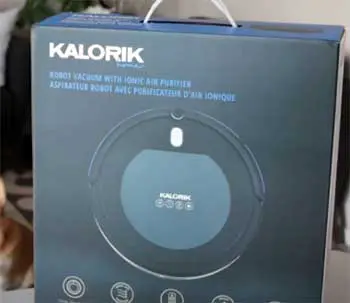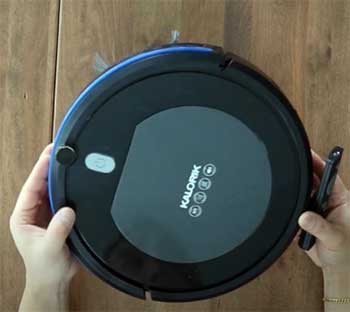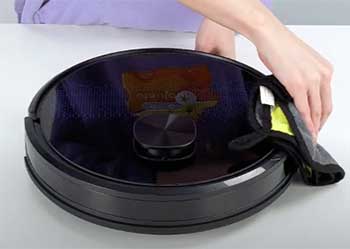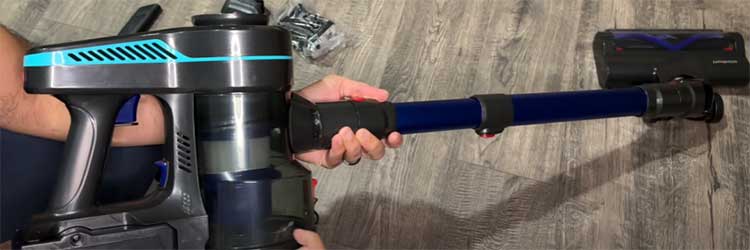When it comes to robot vacuums, there’s no denying that they’re a convenient way to keep your home clean without much effort. You simply set them up, and off they go, handling the vacuuming while you focus on other tasks.
That’s the dream, right? But as with any product, not all robot vacuums are created equal, and today, I’ll be sharing my experience and thoughts on the Kalorik Robot Vacuum.
If you’re considering picking one up, this review should give you a clear picture of whether it’s worth your time (and money).
My Experience With Kalorik Robot Vacuum

When I first got the Kalorik robot vacuum, I was excited to finally have a device that could help with the never-ending battle against dust and dirt. Its slim profile was appealing, especially since I have a lot of low furniture that’s tough to clean under.
Setting it up was straightforward, and I liked the four cleaning modes it offered. However, my initial excitement quickly wore off.
The vacuum ran for about 10 minutes before the battery died, which meant I had to recharge it constantly. The dustbin was tiny, and since I have a dog, I found myself emptying it every few minutes.
It got stuck often—especially around chair legs and under furniture—making the “hands-off” experience not as smooth as I had hoped. The lack of smart navigation became frustrating as it would miss entire sections of the floor while going over the same spot repeatedly.
I did appreciate the HEPA filter for trapping allergens and improving air quality, but that wasn’t enough to outweigh the frequent interruptions. After a few weeks of use, I gave up on it. The constant recharging and manual intervention made it more of a hassle than a help.
In hindsight, I wish I had invested in a more reliable model. The Kalorik robot vacuum simply didn’t live up to my expectations.
Pros of The Kalorik Robot Vacuum
Let’s start with the positives because, despite some serious drawbacks, the Kalorik Robot Vacuum does have a few redeeming qualities.

- Slim Design for Hard-to-Reach Places: One of the standout features of this vacuum is its slim, low-profile design. If you’ve ever struggled to clean under your furniture or in tight spaces, this vacuum fits where most upright vacuums can’t. It gets under low-hanging couches, beds, and cabinets, making it an asset if those areas are particularly dusty.
- HEPA Filter for Cleaner Air: Another selling point is the HEPA filter. For those who suffer from allergies or simply want to ensure that their home air is as clean as possible, the HEPA filter traps dust, dirt, and even pet hair, improving overall air quality. This is especially helpful in homes with pets or in locations with high pollen counts.
- Multiple Cleaning Modes: The Kalorik robot vacuum comes equipped with four cleaning modes: Auto Sweep, Focus Sweep, Random Sweep, and a manual mode that lets you control it with a remote. This variety allows you to tailor the vacuum’s cleaning efforts to specific areas, whether you want it to focus on high-traffic zones or give the entire house a quick once-over.
- Anti-Fall Sensors: I have stairs in my house, and one of my fears when I first started using robot vacuums was that they would tumble down the stairs. The Kalorik vacuum features anti-fall sensors, which ensure that it won’t plummet over edges or stairs. This safety feature works well, and I’ve never had an issue with it falling or damaging itself.
- Affordable Price Point: At around $79, the Kalorik robot vacuum is priced far below many of its competitors, making it an attractive option for anyone on a budget. If you’re new to robot vacuums and want to try one without spending a lot, the price is undoubtedly appealing.
Cons of The Kalorik Robot Vacuum
While the Kalorik Robot Vacuum sounds great on paper, there are several major downsides you should be aware of before committing.

- Poor Battery Life: The biggest drawback, in my opinion, is the battery life. Many users, including myself, have found that the vacuum barely runs for 10 minutes before needing a recharge. Some report even shorter battery life. While this may be acceptable in a small room, it becomes a significant issue if you’re trying to clean larger areas. Having to recharge the vacuum constantly defeats the purpose of hands-off cleaning.
- Tiny Dust Bin: If you have pets or if your floors collect a lot of dirt, the small dust bin will be a constant source of frustration. The vacuum’s dustbin fills up quickly—after just a few feet of cleaning in some cases—especially in homes with pets that shed. This means frequent emptying, which can be more of a hassle than simply vacuuming manually.
- No Smart Mapping Technology: Unlike more expensive models that map out your home to create efficient cleaning paths, the Kalorik vacuum operates randomly. This lack of mapping results in it getting stuck frequently, and sometimes it repeatedly returns to the same spots while missing entire sections of your home. If you’re looking for a vacuum that will cover every corner consistently, this model will likely disappoint.
- Limited Battery Power Affects Performance: The short battery life isn’t the only issue with the vacuum’s battery. The vacuum doesn’t charge properly in many cases, which has been a common complaint among users. Several reviews indicate that some units never fully charge, and others stop working entirely after a few uses. This suggests inconsistent quality control in manufacturing.
- No Self-Charging Feature: Another downside is that this vacuum doesn’t return to its charging dock when the battery is low. More advanced models will automatically head back to their charging station when they need a boost, but with the Kalorik, you have to manually dock it. This might not be a dealbreaker for some, but it certainly adds an extra step to the cleaning process.
Maintenance Tips For The Kalorik Robot Vacuum
Keeping your robot vacuum in good working condition requires a bit of upkeep, but it’s not too complicated.
- Empty the Dust Bin Frequently: Given the tiny dust bin, it’s essential to empty it after every use. Otherwise, the vacuum can get clogged, and its performance will suffer.
- Clean the HEPA Filter: To maintain air quality, the HEPA filter should be cleaned regularly. Check the manufacturer’s instructions for cleaning the filter, as some may need to be replaced after a certain period.
- Keep Sensors Clean: The anti-fall sensors are critical to preventing accidents, so make sure they’re free of dust and debris. Wipe them down occasionally to ensure they’re working as intended.
- Battery Care: Charge the vacuum fully before use, and avoid using it until the battery is completely drained. If the battery shows signs of dying quickly, it might be time for a replacement.
- Tangle-Free Brushes: If you have long hair or pets, the vacuum’s brushes can get tangled quickly. It’s best to check and clean the brushes regularly to prevent blockages.
Comparing Kalorik With Other Brands
To give you a better sense of how the Kalorik robot vacuum stacks up against its competitors, I’ll compare it with three other budget-friendly models: Lubluelu Robot Vacuum, iHome Robot Vacuum, and HOMPANY Cordless Vacuum. Each has its own strengths and weaknesses, so let’s see how they match up.
- Kalorik Vs. Lubluelu Robot Vacuum

The Lubluelu Robot Vacuum offers a more well-rounded experience compared to the Kalorik.
For starters, it has better navigation with smart mapping technology, which allows it to cover your floors more efficiently without missing spots.
Its battery life is also significantly better, lasting up to 150 minutes on a single charge, which is a far cry from Kalorik’s short runtime. The Lubluelu also features stronger suction power, making it more effective on carpets and for picking up pet hair.
Although Lubluelu is slightly more expensive, its superior performance and user-friendly features make it a much better option if you want reliable, hassle-free cleaning.
- Kalorik Vs. iHome Robot Vacuum

The iHome Robot Vacuum offers some similarities to Kalorik in terms of price and ease of use but brings more to the table in terms of smart home integration.
iHome can sync with Google Assistant and Amazon Alexa, allowing for voice control and app-based operation.
This integration is a major step up from the Kalorik, which lacks smart connectivity altogether.
Additionally, iHome has better battery life and smarter navigation, making it a better choice for homes with more complex layouts.
While both vacuums are considered affordable, iHome delivers more features, making it the better value for your money.
- Kalorik Vs. HOMPANY Cordless Vacuum

Although the HOMPANY Cordless Vacuum isn’t a robot vacuum, it’s still worth comparing since it’s another budget option for those seeking a more hands-on cleaning solution. HOMPANY is cordless, lightweight, and versatile, giving you more control over where and when you clean.
It has a larger dustbin than Kalorik, meaning fewer interruptions to empty it. HOMPANY also boasts a stronger suction power, making it more effective at deep cleaning carpets and upholstery.
While it requires manual effort, the HOMPANY cordless vacuum offers better cleaning performance and fewer frustrations than the Kalorik robot vacuum.
Frequently Asked Questions (FAQ)
In many cases, yes! Robot vacuums can be a fantastic way to keep your floors clean with minimal effort. However, the value depends on the model. Brands like Roomba and Eufy offer great performance, but lower-end models like the Kalorik might not be worth the investment due to their inconsistent reliability.
Dyson’s robot vacuum, while innovative, faced competition from more affordable brands that offered better features. As a result, Dyson decided to discontinue its robot vacuum to focus on other home cleaning products.
As of now, the iRobot Roomba Combo j7+ is highly rated for its vacuuming and mopping abilities. It offers smart mapping, self-charging, and high cleaning efficiency, making it one of the top choices for both vacuuming and mopping.
The lifespan of a robot vacuum varies depending on the brand and model. High-end models like Roomba can last several years with proper maintenance, while lower-end models, like the Kalorik, might have a shorter lifespan due to battery issues and wear on components. Regular maintenance can extend the life of any robot vacuum.
Final Thoughts: Is The Kalorik Robot Vacuum Worth It?
If you’re looking for a budget-friendly robot vacuum, the Kalorik might seem appealing at first glance. However, the numerous cons—including poor battery life, a tiny dust bin, and the lack of smart navigation—make it difficult to recommend.
For a little more money, you could get a more reliable vacuum from a trusted brand like Eufy or Shark.
